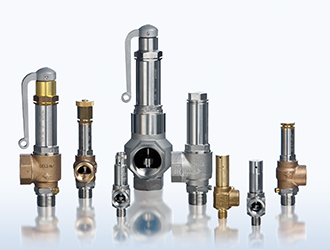
Valve World Expo preview: Peak performance at the lowest temperatures
Mike Edwards
Features cryogenic valves Dusseldorf Germany Valve World Expo The 11th International Valve Trade Fair & Conference will be held November 27-29, 2018 in Dusseldorf, Germany.
The 11th International Valve Trade Fair & Conference will be held November 27-29, 2018 in Dusseldorf, Germany. Cryogenic valves do their job as cold as ice. Demand is growing, as cryogenic processes are becoming more important.

The 11th International Valve Trade Fair & Conference will be held November 27-29, 2018 in Dusseldorf, Germany.
These valves leave a deep impression on their operators. For cryogenic valves defy even the lowest temperatures. A strength which makes them essential not only for the pharmaceutical and food industry. The booming LNG sector is also driving growth. Investing in research and development of cryogenic valves thus make good economic sense.
“Yes, there is a trend towards cryogenic valves,” confirms René Speckmaier, product manager, Goetze KG Armaturen. For the consumption of technical gases is rising annually. This includes oxygen, nitrogen, and argon, as well as the inert gases xenon and krypton. Separating air into its single elements is only economically viable using a thermal separation process. Cryogenic valves are an important component of low-temperature air separation.
Medical engineering as a driver
Hydrogen-based mobility, medical engineering, as well as the global demand for energy and food drive demand for cryogenic process components. Applications such as cryotherapy – i.e. the focused use of coldness to achieve a therapeutic effect, for instance in cancer treatment – open up new fields of business for plant engineering companies.
A sign of growing demand for medical technology – and as such also for the matching valves – is the rising number of patents. According to the German site “Medizintechnologie.de”, published by the VDI Technologiezentrum GmbH, medical technology is booming. In 2015, the European Patent Office (EPO) recorded a new record figure. Compared to the previous year, 1.6 percent more patent applications were filed by individuals, institutions and companies from around the entire world. 2015 a total of 278,867 patent applications were handed in (2014: 274,000).
According to market research firm statista, Germany, the U.S. and Japan are the leading producer countries of medical technology.
Demand from the food industry
The food industry remains attractive for manufacturers of cryogenic valves – with an upward trend. Example Germany: turnover grew here from 116.9 billion euro in 1998 to 168.6 billion euro in 2016 – all in all revenue growth of 44 percent. As such, the food industry has a share of 9.4 percent of total revenues of manufacturing industries.
A trend in the use of cryogenic valves is cryogenic machining: to reduce tool wear through very high process temperatures, for instance in the energy sector, automobile manufacturing and aviation, cryogenic techniques can be utilized.
High requirements
Further fields of use are in refrigeration tunnels, dry ice blasting machines, in liquid nitrogen dosing, in cryogenic grinding plants, in N2 for food and pharmaceutical applications, in refrigeration engineering and the semiconductor industry. Demand is growing nearly on a daily basis: “cryogenics and the necessary valves can be found in nearly all sectors,” explains Olaf Schulenberg, technical director, Goetze KG Armaturen.
 Valves for cryogenic processes face great challenges. They have to resist temperatures of up to minus 200 degree Celsius, handling inert gases, oxygen and LNG. For LiHe (lithium/helium), valves even need to cope with minus 269 degree Celsius.
Valves for cryogenic processes face great challenges. They have to resist temperatures of up to minus 200 degree Celsius, handling inert gases, oxygen and LNG. For LiHe (lithium/helium), valves even need to cope with minus 269 degree Celsius.
Common, however, are “applications to the lowest application temperature of cryogenically liquefied nitrogen up to minus 196 degree Celsius,” explains Schulenberg. Other gases such as oxygen, argon, carbon dioxide would liquefy at higher temperatures. Liquefied natural gas (LNG) has a temperature of minus 163 degree Celsius. “Most valves are therefore designed for temperatures of minus 200 degree Celsius.”
Ductile, but not brittle
Special temperatures require special materials, for example stainless alloyed and high-alloyed steels, nickel-based alloys, copper and copper-based alloys such as bronze and brass. “These materials show high enough ductile values and do not tend towards embrittlement,” emphasizes Schulenberg.
Optimum design is a matter of course for valve manufacturers and end users. Depending on valve, the nominal diameters range from DN6 to DN300, and larger. Pressure can range between 0.2 bar to 500 bar, and above. Application decides the dimensions. “For storage of cryogenically liquefied gases the valve is designed for a maximum of 40 bar pressure, for carbon dioxide also up to 80 bar, and LNG even higher,” comments Schulenberg.
Fitting valve design
Errors in valve design can have grave consequences. The degree of standardization for plants for cryogenic gases is increasing. “The increasing level of standardization of systems for cryogenic gases means that precise design of pressure-relief systems is vital, particularly in view of the potential effects of an incorrectly designed safety valve or a supply line of inadequate dimensions,” according to valve manufacturer Herose. Costs can be horrendous, should an unscheduled replacement campaign become necessary as a result of an incorrectly dimensioned valve.
“The service-lives of safety valves will increase significantly if these elements are designed separately from one another for maximum mass flows for the fire load, and minimum mass flows in case of entirely thermal expansion – the practice which most closely approximates to normal operation,” states Herose.
Various types of valves are required for cryogenic processes, amongst others isolation valves and control valves with manual actuators, pneumatic and electrical actuators – as poppet valves, butterfly valves, ball valves and slide valves. Furthermore, safety valves, pressure-relief valves, check valves, filter and pressure regulators are used.
LNG is the market of the future
Cryogenic valves are in great demand, and LNG is their future – as many experts agrees. Worldwide capacity amounted to around 275 million tonnes in 2015.
A further 65 million tonnes will be added by 2018. Experts view growth of LNG demand as reliable: until 2030 demand “is set to grow at twice the rate of gas demand, at 4 to 5 percent a year between 2015 and 2030,” foresees Maarten Wetselaar, integrated gas and new energies director, Shell. China and India were the buyers with the highest growth. The two countries increased imports by 11.9 million tonnes in 2016. China and India will continue to drive demand.
Six new importing countries have furthermore contributed to LNG demand: Colombia, Egypt, Jamaica, Jordan, Pakistan and Poland. Meanwhile the number of LNG importing countries has grown to 35, compared to ten at the turn of the century. Shell therefore sees additional investments have to be made, in order to meet growing demand, most of which is set to come from Asia, after 2020. In China, a government target has been set for gas to make up 15 percent of the country’s energy mix by 2030, up from 5 percent in 2015. Manufacturers of high-quality cryogenic valves will find a lucrative market in Asia.
Efficient and environmentally friendly
It is not too much of a surprise LNG offers a great outlook. Its volume is 600 times smaller compared to natural gas, in its gaseous state. This allows it to be transported and stored far more efficiently. And it is versatile: LNG can be used as a raw material and as a source of energy, as well as a fuel for ships and trucks.
In addition, liquefied natural gas is far more environmentally friendly than all other fossil fuels – for instance when fueling ships. “LNG contains neither sulphur nor heavy metals and reduces the CO emissions by 20 to 30 percent and the NOX emissions (nitrogen monoxide and nitrogen dioxide) by approx. 90 percent compared to fuel oil,” reports valve manufacturer Herose.
Even though Herose sees “gaps in the development of an LNG infrastructure with full coverage and there is not yet a sufficient number of bunkering points for ships,” the company declares. “The future belongs to the construction of LNG-operated ships”. Trucks are also increasingly using LNG as fuel, in Europe more than 900 LNG operated trucks are in service.
Safety first
Herose has recognised the potential of liquefied gas and belongs to the leading suppliers in the LNG market. This includes certified small-scale valves with approval according to ISO 10479 for fire safe design. After all, safety first is the motto here.
Requirements for LGN valves are high. “Trailers for cryogenic liquefied natural gas are exposed to frequent filling, transportation and unloading at the destination under extreme conditions,” explains Herose. For LNG storage, service life and performance are just as important as absolute safety and reliability. High-performance valves are also required for fuelling LNG. This is proof of the high requirements cryogenic valves must fulfil.
This article was provided by Valve World Expo Düsseldorf to be held 27 – 29 November, 2018 at Düsseldorf Fairgrounds.
Print this page
